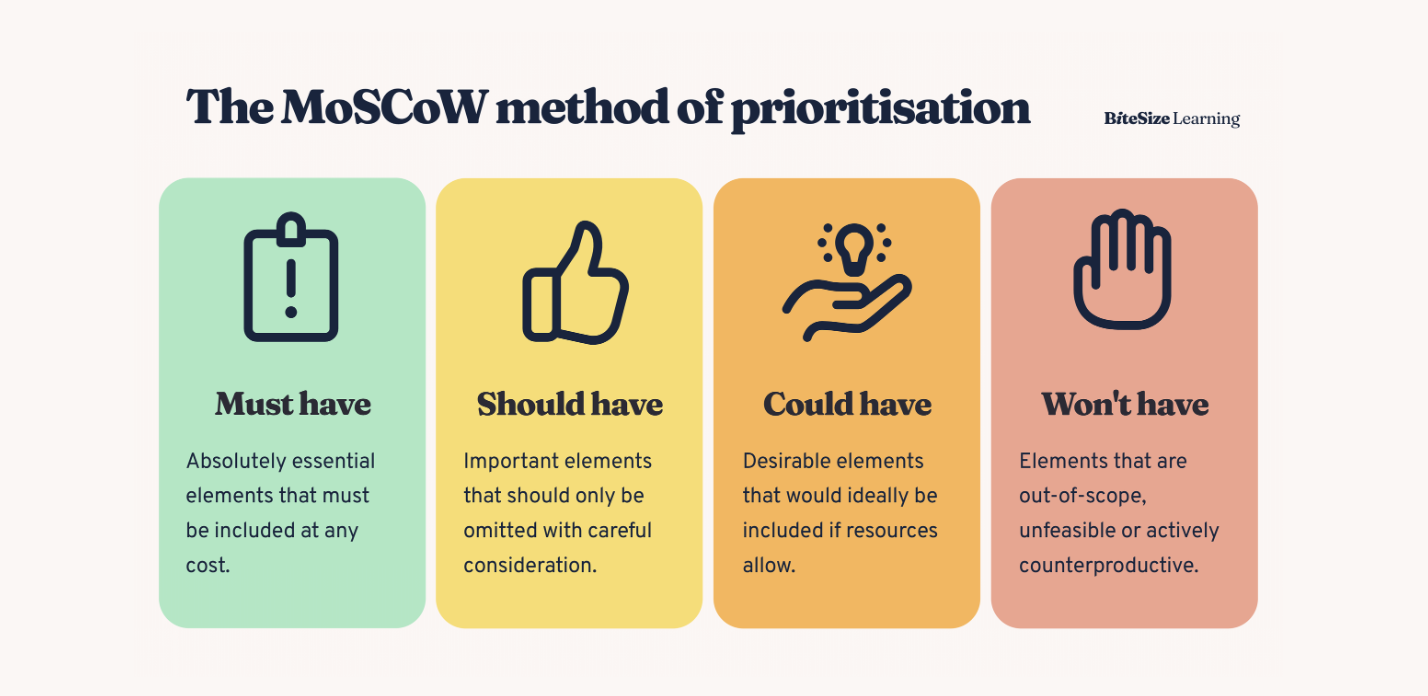What are the 5 P’s for strategy?
As you strive to become a more effective manager or team leader, you might be looking for ways to sharpen your strategic thinking skills.
One framework that could be useful to consider is Mintzberg's 5 P's of Strategy. This captures five dimensions that any strategy can be built around – perhaps just one, hopefully a few, or even all of them!
It provides a comprehensive way to analyse and develop meaningful, easy-to-understand strategies.
So, what are the 5 P's? They stand for Plan, Ploy, Pattern, Position, and Perspective. Let's break each one down.
The 5P’s of strategy explained
Click to enlarge. Feel free to download and use with a link to BiteSize Learning.
Plans: ‘We will…’
This is the most traditional, execution-focused view of strategy. It involves setting clear goals, determining actions to achieve those goals, and allocating resources accordingly. When crafting a plan, ask yourself: What are our objectives? What steps do we need to take to reach them? What resources (time, money, people) will we need?
A degree of planning is, of course, essential: a ‘strategy’ without any tangible plan is unlikely to come to fruition – it’s just a dream, an insight, or belief.
That said, a plan standing alone is not quite a strategy. Instead, it’s more of an epic to-do list with a big goal at the end. While it captures what you’re going to do, it doesn’t explain why you’ll expect it to work. What’s the big idea behind the plan?
Strategies are distinguished from complex plans because they are designed to deal with the unexpected – the volatile, uncertain, complex and ambiguous, if you will – so can’t be planned down to the least detail. That’s why we usually talk about ‘strategy’ when it comes to objectives involving ‘external forces’ like competitors, the public, and other unpredictable stakeholders – military strategy, sporting strategy, marketing strategy, political strategy and PR strategy being just a few examples.
Ploys: ‘We’ll win by…’
Sometimes, strategies are focused on out-manoeuvring competitors.
A ploy-based strategy is a specific move designed to gain an advantage or deter rivals. For instance, it could be based around an innovation that an incumbent would be uncomfortable copying because it disrupts their existing business model.
Ploys are more common in highly concentrated industries, where there are just a few specific opponents that the strategist has in mind. A startup search engine, for example, would need to have a clear idea of how to get people to switch from Google. Or, in politics, a communications strategy might involve taking a bold and headline-grabbing stance on a popular measure, thereby forcing the opposition into either agreeing with you or admitting their opposition.
However, a ploy-based strategy risks becoming too obsessed with ‘winning against X’, and might miss the bigger picture of how the effort might succeed on its own terms, or avoid head-to-head competition altogether. Your opponent may be, as the saying goes, living in your head rent-free.
Patterns: ‘We always…’
Patterns are often ‘emergent’ strategies that arise from previous success, or double-down on doing things the things that work best.
Perhaps you have a technical team that’s made a recent breakthrough, and lately you can manufacture Widgets a lot more easily. Right now, that’s a decent win – but this breakthrough might now enable an entirely new strategy, using your new process to manufacture all kinds of new widgets and enter new markets that were previously out of reach.
In short, patterns are a ‘recipe for success.’ Picture how a sports team can become ascendant by employing a new tactical approach which, combined with the right players, befuddles all manner of opposing teams.
By examining patterns in your team's actions and decisions, you can identify your "realized" strategy (what you're actually doing) and compare it to your "intended" strategy (what you planned to do).
And ask yourself: what if you went ‘all-in’ on whatever currently works best, and just did that all the time?
Positions: ‘We’ll be the best ☁️ for ☁️…’
Positional strategies focus on who the end user, customer or audience is, and how they’ll perceive your work. This position then informs other parts of your strategy, like the product.
For instance, ‘cake for breakfast’ is a controversial proposition, but if you call it a ‘muffin’, suddenly it’s an delicious way to start the day! Positioning your cupcake as a breakfast food might, in turn, suggest slightly healthier recipes, like blueberries or low-fat varieties. In this scenario, your competitors would include croissants, cereal and ‘just skipping breakfast.’
But if you want to sell cake as a dessert, then you might want to make it more of treat – your competitors might include indulgent puddlings like ice cream, fruit crumbles and gateaux. In this scenario you might develop your product to offer a boozy filling or sticky glaze – an altogether different approach.
Choosing a position should also be informed by where your strengths and weaknesses currently lie, and ‘going with the grain.’ For instance, if your product is not especially advanced, it might make sense to aim it at a less sophisticated customer, emphasising how simple, straightforward and user-friendly it is.
With the revenue from these initial customers, you might later choose to invest in adding further features, allowing you to meet the needs of a more demanding client base.
Perspectives: ‘We believe…’
Perspective-based strategies offer a certain insight or viewpoint in how things are. This might be a philosophical belief, some insider knowledge, or a striking data point. You see what others don’t, or emphasise an uncomfortable truth that others would rather avoid.
It’s a gap in the market, a better understanding of the customer, or a simple motto that
Or it might simplify a complex situation into a core principle that receives an unusual amount of prioritisation.
‘Whenever we have possession of the ball, the other team will not be able to win.’
‘None of the restaurants in our town are good for vegetarians. We will be.’
‘It should be easier to book a GP appointment than ringing up at 8.01am.’
‘Laptops can be as desirable as jewellery.’
Many of these perspectives and beliefs exist as tacit assumptions within an organisation, but a strategy can make them explicit – and also put them to a test. Some of these assumptions might be past their sell-by date.
Perspective-based strategies can be clarifying, because it’s usually easy to tell if new ideas and projects aligns with this central viewpoint. But if the perspective is not well-supported by reality, it becomes more of a dogmatic belief.
Implementing the 5P’s for strategy
To put the 5 P's into practice, start by assessing your current strategy through each lens. Identify areas where you're excelling and ones that need improvement. Then, use the framework to craft a more holistic, effective strategy:
Develop a clear plan with specific goals and action steps.
Consider potential ploys to gain a competitive edge.
Analyze patterns to ensure your realized strategy aligns with your intended one.
Determine the category, marketplace and customer profile of your position.
Articulate the key perspectives that inform your strategy.
The 5 P's can also be a valuable tool for communicating strategy to your team. By breaking it down into these distinct elements, you can help everyone understand their role in the bigger picture and make more strategic decisions day-to-day.
As you integrate the 5 P's into your strategic thinking, remember that strategy is an ongoing process. Regularly reassess and adjust your approach based on new information, changing circumstances, and lessons learned. By staying proactive and adaptable, you'll be well-equipped to lead your team to success.
Mintzberg's 5 P's offer a powerful framework for analyzing and developing strategy. By considering each aspect - plan, ploy, pattern, position, and perspective - you can craft a more comprehensive, effective approach. So next time you're faced with a strategic challenge, break out the 5 P's and see how they can guide you to a winning solution.
Original reading: The Strategy Concept I: Five Ps for Strategy, Henry Mintzberg, 1987







